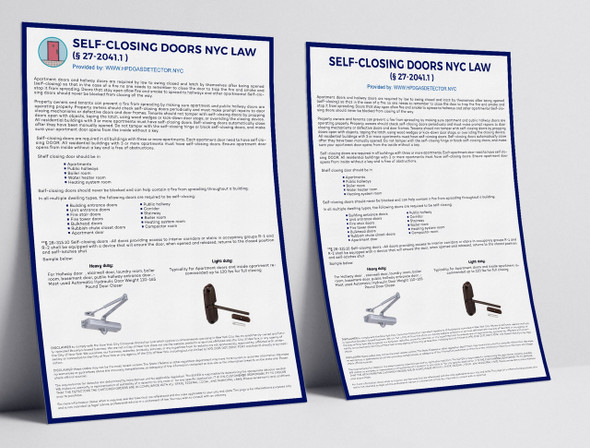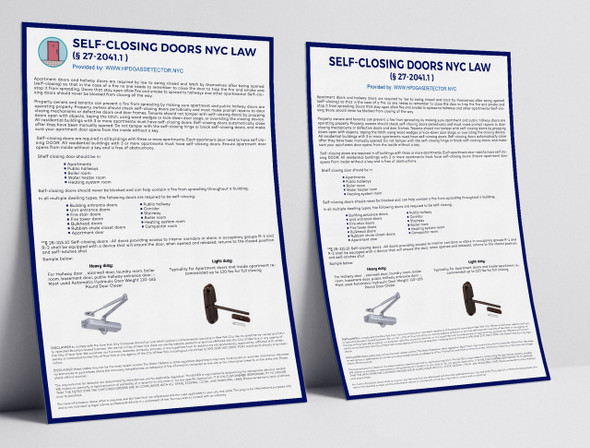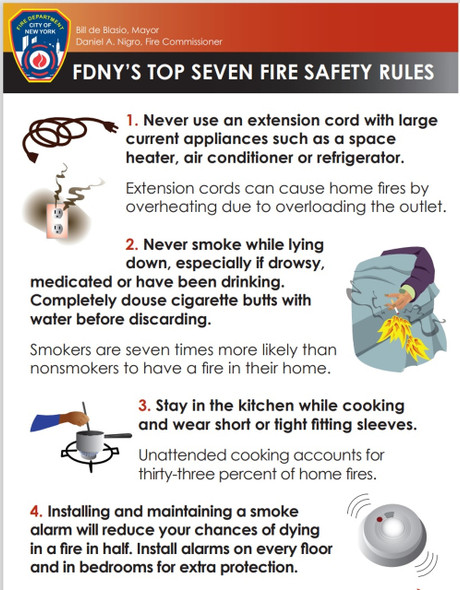Description
Self-Closing Door ( NYC Local Law 27-2041.1 )
Single torsion spring is ideal for APARTMENT DOOR AND ROOM DOORS UP to 57 lbs. (26kg) of force with an adjustable closing speed. Neat, compact, and durable white-painted . Reversible handing. Do not overtighten, turning past 4 hole positions will cause this item to fail..
Highlights
- Designed for closing Apartment doors, rooms doors ,gates or screens with up to 57 pounds of force
- Compact and durable
- Non-handed for right or left handed doors
- white finish
- Includes adjusting bar
- Adjustable closing speed
- Do not overtighten, turning past 4 hole positions will cause this item to fail
New York City, known for its towering skyscrapers and densely populated neighborhoods, has a vested interest in ensuring the safety of its residents. One of the essential safety measures enacted by the city is the requirement for self-closing doors in multiple dwellings. This regulation is codified under NYC Administrative Code 27-2041.1. This article explores the origins, specifics, and implications of this crucial safety regulation.
Origins and Purpose
The primary purpose of NYC Local Law 27-2041.1 is to enhance fire safety in residential buildings. Fires in apartment buildings can spread rapidly, making it critical to contain them as much as possible. Self-closing doors play a significant role in this containment. By automatically closing after being opened, these doors help to prevent the spread of fire and smoke, thereby protecting residents and allowing them more time to evacuate.
The Requirements
Under NYC Administrative Code 27-2041.1, the law mandates that all apartment doors leading to public hallways must be equipped with self-closing mechanisms. Here are the key points of the regulation:
- Applicability: This requirement applies to all multiple dwellings, which include buildings with three or more separate residential units.
- Door Types: The law specifically targets doors that open into public hallways, stairwells, and other common areas.
- Mechanism: The doors must have a mechanism that ensures they automatically close and latch shut when not actively held open. This mechanism can be either a door closer or a spring hinge.
- Maintenance: Property owners are responsible for ensuring that these self-closing mechanisms are always functional. Regular maintenance checks are required to keep the mechanisms in working order.
- Compliance Deadlines: Building owners were given specific deadlines by which they had to comply with this requirement. Failure to comply can result in significant fines and penalties.
Implications for Property Owners
For property owners, the self-closing door requirement means both an initial investment and ongoing maintenance costs. Installing self-closing mechanisms on all applicable doors can be a considerable expense, especially for larger buildings. However, the cost of non-compliance can be even higher. The city imposes fines for each door found to be non-compliant during inspections.
Enforcement and Penalties
The NYC Department of Housing Preservation and Development (HPD) is responsible for enforcing this regulation. During routine inspections, HPD inspectors check for compliance with the self-closing door requirement. If a door is found not to be self-closing, the property owner is issued a violation and given a timeframe to rectify the issue. Failure to address the violation can lead to substantial fines, compounding with each subsequent inspection until compliance is achieved.
Benefits and Impact
The self-closing door requirement significantly enhances fire safety in residential buildings. By containing fires and smoke, these doors help to:
- Save Lives: Contained fires allow residents more time to evacuate safely.
- Protect Property: Limiting the spread of fire reduces damage to the building and individual apartments.
- Facilitate Firefighting Efforts: Firefighters can control and extinguish fires more effectively when they are contained to specific areas.
Conclusion
NYC Administrative Code 27-2041.1's self-closing door requirement is a vital safety measure that underscores the city's commitment to protecting its residents. While compliance may pose challenges for property owners, the benefits in terms of safety and property protection are invaluable. By adhering to this regulation, building owners contribute to a safer living environment for all New Yorkers, reflecting the city's proactive stance on fire safety and emergency preparedness.
DISCLAIMER DISCLAIMER ON LEGAL CODES DISCLAIMER ON SIGN USE GENERAL INFORMATION DISCLAIMER
We are a small, family-owned and family-operated Brooklyn-based business. We are not a City of New York store, nor are our website, products, or services affiliated with the City of New York or any agency of the City of New York. Neither we, nor our business, websites, products, services, or any hyperlinks from our website are sponsored by, approved by, affiliated with, endorsed by, or connected to the City of New York or any agency of the City of New York, including but not limited to HPD, DOB, DOT, DSNY, FDNY, or any federal entity, directly or by implication.
The codes, regulations, and requirements referenced on our website may not represent the most recent or updated versions. State, federal, or local regulatory agencies may have more current or accurate information. We make no warranties or guarantees about the accuracy, completeness, or adequacy of the information provided on this site or linked from it. Customers should verify all information by reviewing the official sources directly.
The requirements for sign content depend on intended use and applicable laws. The buyer is solely responsible for determining the appropriate content for a sign or package of signs. We make no warranty or representation regarding the suitability of any sign for a specific application. It is the customer’s responsibility to ensure that the signs ordered are in compliance with all applicable state, federal, local, and municipal laws. Customers are encouraged to carefully review our Terms and Conditions prior to purchase.
All content on this site is provided for informational purposes only and does not constitute legal advice, professional advice, or a definitive statement of law. For guidance on specific requirements, customers should consult the laws and regulations referenced, as well as any rules applicable in their jurisdiction. You may wish to consult with an attorney or qualified professional to ensure compliance with all applicable legal obligations.
























